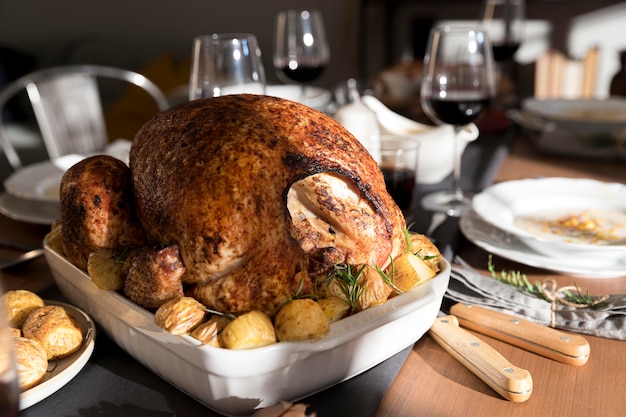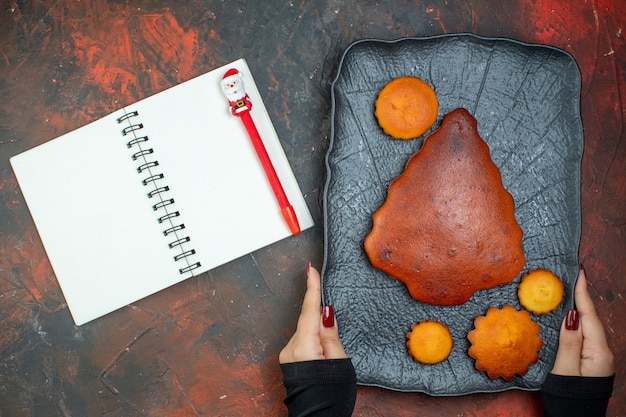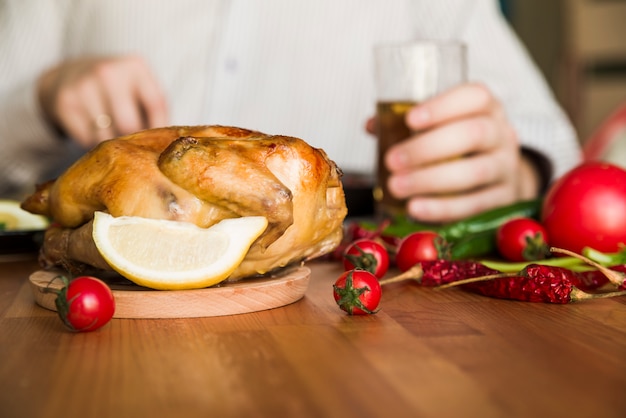(Part 1) choosing the right cut: The Foundation of Flavor

Why Round Roast Reigns Supreme
There's a reason round roast is a favourite for Sunday lunches. It's not only budget-friendly, but it also boasts an incredible combination of tenderness and flavour. It's a leaner cut, meaning it's less likely to dry out during cooking, and it holds its shape beautifully.Shopping for the Perfect Piece
When you're at the butcher's, don't just grab the first round roast you see! Take a minute to choose the best piece for your feast: Marbling, the Key to Juiciness: Look for meat with a good amount of marbling – those delicate streaks of fat running through the muscle. This marbling isn't just for looks; it's what gives your roast that incredible melt-in-your-mouth juiciness. Colour Counts: A vibrant, rich red colour indicates fresh, high-quality meat. Avoid any pieces that are pale or have a dark, purplish hue. Feel for Firmness: A good round roast should feel firm and springy to the touch, not mushy or overly soft. This is a sign of good quality and ensures a delicious result.(Part 2) Preparing the Roast: Enhancing Flavour

Seasoning for Maximum Impact
Salt and pepper are the basics, but don't stop there. Think of seasoning as adding layers of flavour that build on the natural richness of the meat. Herbs and Spices: Fresh rosemary, thyme, and garlic are classic choices. I love rubbing a blend of these herbs into the roast, letting their aromas permeate the meat as it cooks. Spice Things Up: Don't be afraid to get creative. Experiment with a pinch of paprika, a touch of cumin, or even a dash of ginger for a subtle flavour boost. The Power of Brining (Optional): Brining involves soaking the roast in a salt solution, which draws moisture into the meat, making it incredibly tender and juicy. This is especially helpful if you're using a leaner cut. It's not necessary for all roasts, but it's a wonderful technique to consider.The Pat-Down Trick: A Crisp Skin Secret
After you've seasoned your masterpiece, pat it dry with paper towels. This might seem like a small detail, but it makes a big difference! By removing any excess moisture, you allow the skin to crisp up beautifully, creating a delicious layer of flavour.(Part 3) Cooking the Roast: The Art of Heat and Time

Oven Roasted: The Classic Choice
For a traditional roast dinner, the oven is your trusty companion. It's reliable, straightforward, and delivers consistently delicious results.- Preheat Your Oven: Set your oven to 180°C (350°F). This ensures the roast cooks evenly from the inside out.
- The Roasting Rack: A roasting rack elevates the roast off the bottom of the pan, allowing hot air to circulate freely and creating a beautiful, crisp exterior.
- cooking time: Aim for about 30 minutes per pound of roast. However, you can always adjust the time based on your preferred level of doneness. A meat thermometer is your best friend for ensuring perfect cooking.
- Resting is Key: After cooking, let the roast rest for 10-15 minutes before carving. This allows the juices to redistribute, leading to an incredibly juicy and flavourful outcome.
slow cooker: Tenderness and Comfort
If you're looking for a melt-in-your-mouth tenderness, the slow cooker is your go-to. It allows the roast to simmer gently, breaking down the connective tissue for an unbelievably soft and flavourful experience.- liquid base: Place the roast in your slow cooker and cover it with your choice of liquid – water, broth, or even a splash of beer! The liquid helps to keep the meat moist and adds another layer of flavour.
- Low and Slow: Set your slow cooker to low and cook for 6-8 hours. If you're short on time, you can cook on high for 3-4 hours.
- Rest Time: After cooking, allow the roast to rest for 15-20 minutes before carving.
(Part 4) Roasting Vegetables: Enhancing the Feast
A roast dinner isn't complete without a selection of perfectly roasted vegetables. They add colour, texture, and a burst of fresh flavours that complement the richness of the meat.Choosing Your Veggie Sidekicks
The beauty of roasted vegetables is that you can choose whatever you love. Here are a few classic pairings that always hit the spot:- Potatoes: starchy potatoes, like maris piper or king edward, are perfect for roasting. They soak up the flavours of the roast and develop a delightful, fluffy texture.
- Carrots: A timeless classic, carrots add a touch of sweetness and vibrant colour to your plate.
- Parsnips: These root vegetables offer a unique flavour profile and complement the roast beautifully.
- Brussels Sprouts: A bit of an acquired taste, but when roasted, Brussels sprouts transform into deliciously caramelized bites.
Roasting Vegetables to Perfection
To ensure your vegetables are tender and beautifully caramelized:- Chop It Up: Cut the vegetables into bite-sized pieces. This ensures they cook evenly and are easy to eat.
- Olive Oil and Seasoning: Toss the vegetables with olive oil, salt, pepper, and your favourite herbs. Fresh rosemary and thyme are always a great choice.
- Single Layer for Even Cooking: Spread the vegetables in a single layer on a baking sheet. This prevents them from steaming, allowing them to roast beautifully.
- Roast Time: Bake the vegetables for 30-40 minutes, or until tender and slightly caramelized.
(Part 5) Making the Gravy: The Essence of Flavor
Gravy is the ultimate finishing touch. It brings all the flavours of the roast and vegetables together in a rich, savoury sauce that elevates your entire meal.The Secrets of the Pan Drippings
The magic of gravy begins with those golden pan drippings. After your roast is cooked, pour off any excess fat. Then, add a splash of liquid (water, wine, or stock) to the pan. Scrape up any tasty bits that have stuck to the bottom, creating a base for your gravy.Thickening to Perfection
You can use various methods to thicken your gravy. Here are some popular options:
- Flour: Whisk a tablespoon or two of flour into the pan drippings and cook until it forms a smooth paste. Gradually whisk in your chosen liquid until you achieve the desired consistency.
- Cornstarch: Mix cornstarch with a little cold water to form a slurry. Whisk this slurry into the pan drippings, stirring constantly until the gravy thickens.
- Gravy Granules: For a quick and easy option, use good-quality gravy granules. Add them to the pan drippings and whisk until dissolved.
Adding Flavour to Your Gravy
Don't be afraid to experiment with different flavours:
Herbs: A sprig of rosemary, a pinch of thyme, or a squeeze of lemon juice can enhance the flavour of your gravy. Wine: A splash of red wine adds a depth of flavour, especially if you've used red wine in the cooking process. Worcestershire Sauce: A touch of Worcestershire sauce adds a savoury umami note.(Part 6) Carving the Roast: A Triumphant Moment
The moment of truth has arrived! Carving the roast may seem daunting, but it's a surprisingly simple task.The Right Tools
Sharpen Your Knife: A sharp carving knife is essential. It cuts cleanly through the meat without tearing. Steady Your Roast: Use a carving fork to hold the roast securely while you slice.Carving Technique
- Against the Grain: Slice the roast thinly against the grain. This ensures the meat is tender and easy to chew.
- Presentation Matters: Arrange the carved slices on a serving platter in an appealing manner.
- Gravy Time: Generously ladle the delicious gravy over the roast and vegetables.
(Part 7) Serving the Feast: The Grand Finale
The table is set, the aroma is intoxicating, and your masterpiece is ready to be devoured!Plating Perfection
You have a few options when it comes to plating:
- The Platter Approach: Serve the roast on a large platter, surrounded by the roasted vegetables. Allow guests to carve their own slices and enjoy.
- Individual Plates: Create beautiful, individual plates with a generous portion of roast, a selection of roasted vegetables, and a generous spoonful of gravy. This is perfect for formal dinners.
Accompaniments: The Supporting Cast
No roast dinner is complete without a few classic accompaniments:
- yorkshire puddings: These golden, fluffy puddings are a must-have for any traditional roast dinner. They're the perfect vessel for soaking up the gravy.
- Stuffing: This comforting side dish can be made with bread, sausage meat, or even chestnuts. It adds texture and flavour to the meal.
- Cranberry Sauce: A sweet and tangy counterpoint to the richness of the roast.
- Bread Sauce: A creamy, comforting sauce that's particularly delicious with roast chicken or turkey.
(Part 8) Leftovers: More Deliciousness to Come
One of the best things about a roast dinner is the delicious leftovers! Don't let them go to waste; transform them into new culinary delights.Roast Dinner Sandwiches: A Hearty Treat
This is my go-to way to use up leftover roast:
Layer It On: Pile slices of roast, gravy, roasted vegetables, and a bit of stuffing onto crusty bread. Toasted for Extra Goodness: Toast the sandwich for a warm, comforting snack.Roast Dinner Soup: A Warm Embrace
You can turn your leftovers into a nourishing and flavourful soup:
Chop It Up: Cut the leftover roast and vegetables into small pieces. Simmer and Blend: Add the chopped ingredients to a pot with broth or stock. Simmer until the vegetables are tender, then blend the soup until smooth.(Part 9) Tips and Tricks: Elevate Your Roast Game
Over the years, I've learned a few tricks of the trade. Here are some extra tips to help you create the perfect roast:- Space Matters: Don't overcrowd the roasting pan. The roast needs space to cook evenly.
- The Thermometer Tells the Tale: Use a meat thermometer to check the internal temperature of the roast and ensure it reaches your desired level of doneness.
- Rest for Juiciness: Always allow the roast to rest for at least 10 minutes before carving. This lets the juices redistribute, making the meat incredibly tender and flavorful.
(Part 10) FAQs: Your Burning Roast Questions Answered
Q1: How do I know when my round roast is cooked?
Use a meat thermometer to check the internal temperature. For medium-rare, the temperature should be 145°F (63°C). If you prefer a more well-done roast, cook it to 160°F (71°C).
Q2: Can I cook a round roast from frozen?
It's best to avoid cooking a round roast from frozen. It will take much longer to cook and may not be evenly cooked. It's best to thaw it in the fridge overnight for consistent results.
Q3: Can I reheat leftover roast?
Absolutely! Simply slice the leftover roast into thin pieces and place them on a baking sheet. Bake in a preheated oven at 350°F (175°C) for 15-20 minutes, or until heated through.
Q4: How long can I keep leftover roast in the fridge?
You can safely store leftover roast in the fridge for 3-4 days. Make sure to wrap it tightly to prevent freezer burn.
Q5: What are some other delicious sides to serve with a round roast?
You've got endless options for sides! Here are a few favourites:
- mashed potatoes: A comforting classic that pairs perfectly with roast beef.
- green beans: A fresh and vibrant side dish that adds a bit of crunch.
- Peas: A simple but essential addition to any roast dinner.
- sweet potato Casserole: A sweet and savoury option that adds a touch of indulgence.
- Garlic Bread: A delicious way to soak up all the flavours of the gravy.
And there you have it – your comprehensive guide to cooking a delicious round roast. Now, get out there, choose your favourite cut of meat, and unleash your culinary creativity! Remember, every roast is a journey of flavour. Happy roasting!
Everyone is watching

How to Cook Frozen Lobster Tails Perfectly: A Step-by-Step Guide
RecipesLobster. Just the word conjures up images of lavish meals, special occasions, and a taste of luxury. But let's...

Pigs in a Blanket Cooking Time: How Long to Bake for Perfect Results
RecipesAh, pigs in a blanket. Just the name conjures up images of those delightful little parcels of crispy pastry en...

Pork Fillet Cooking Time: How Long to Cook It Perfectly
RecipesPork fillet, or tenderloin as it's sometimes called, is a real favourite in our house. It's so versatile, and...

The Ultimate Guide to Cooking Delicious Frankfurters
RecipesLet's face it, we all love a good frankfurter. It's a classic, simple, and always satisfying. But let's be rea...

Wolf Meat Recipes: A Guide to Cooking Wild Game
RecipesLet's be honest, you don't see wolf meat at your local butcher shop every day. It's a bit of a wild card, but ...
